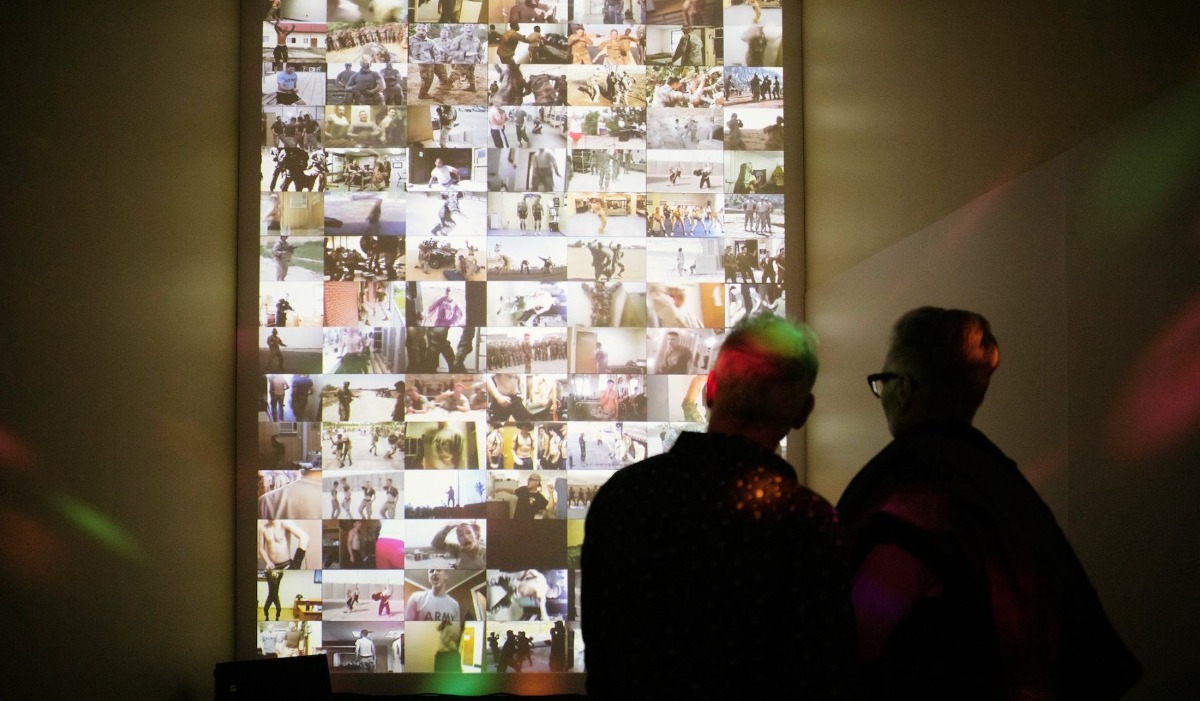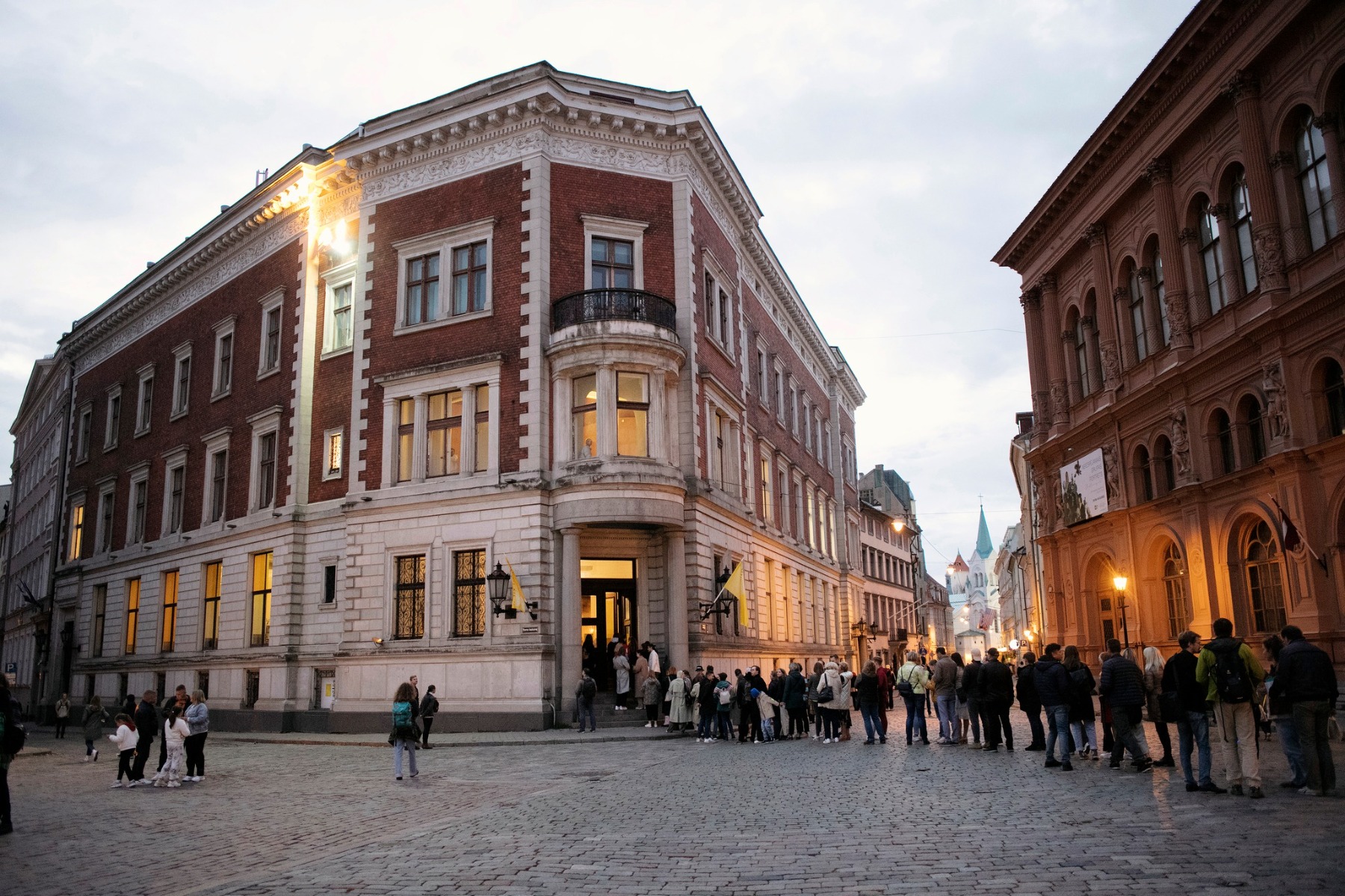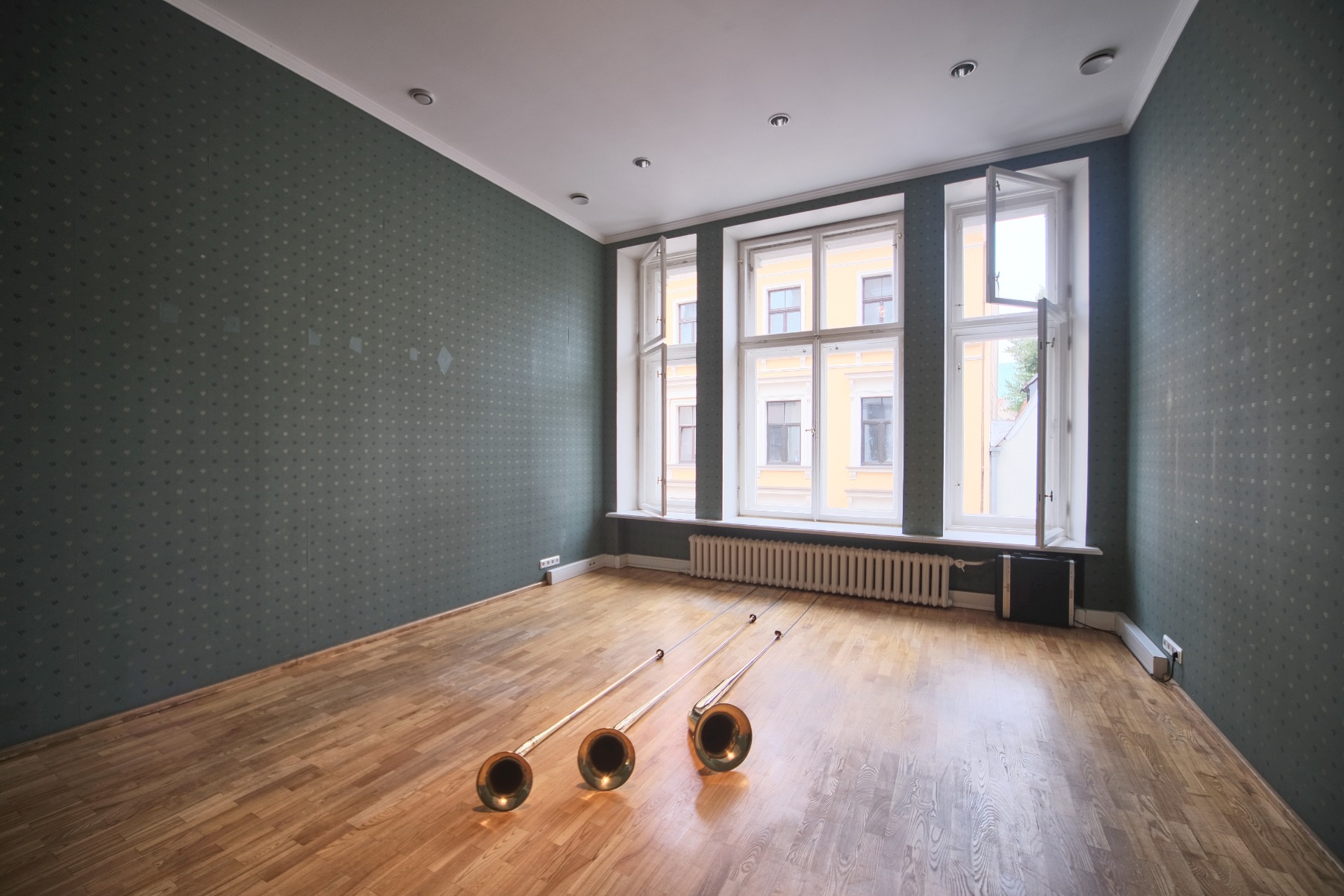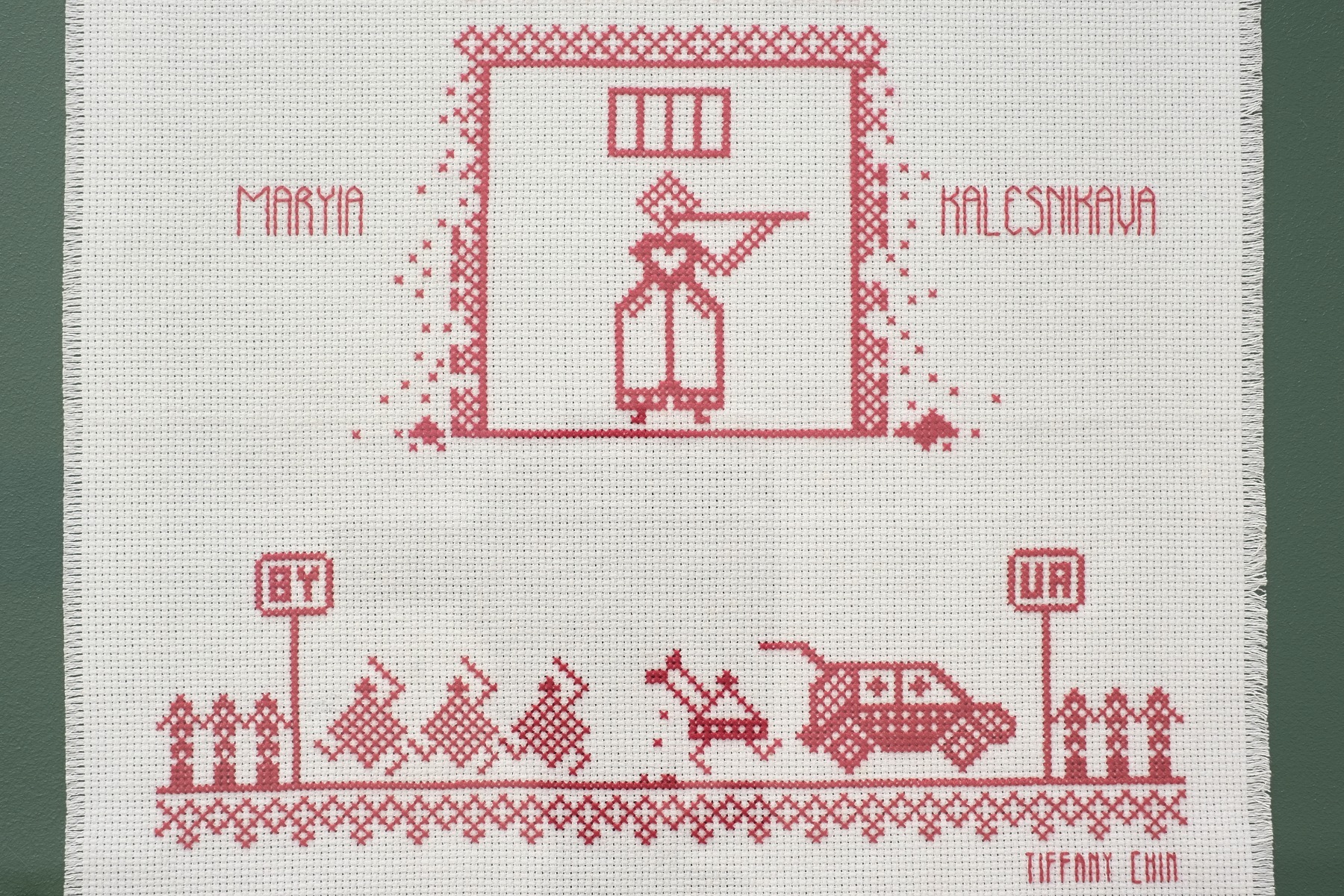
Spasm of Silence
The 13th international festival of contemporary art Survival Kit runs in Riga through 16 October 2022
The annual international festival Survival Kit responds to current crises and acute problems of the present day. Since its foundation, the festival has been held by the Latvian Centre for Contemporary Art.
The key theme of the latest ‒ 13th ‒ edition of the festival, running though mid-October, is fight with authoritarianism and radical right politics. The Greek-born curator iLiana Fokianaki has chosen a line from a poem by the Latvian poet Ojārs Vācietis ‒ ‘The little bird must be caught’ ‒ as the title of this year’s programme.

The festival is taking place in an imposing 19th-century building, a former bank, right next door to the Riga Dome Cathedral. In other words, the venue of this programme, centred around the concept of freedom, comprising the exhibition, panel discussions, workshops and the rest of it, is a former citadel of imperial financial capital. Such a location presumes multi-filtered optics on the problems. And these complex filters have been installed by the organizers of the exhibition with genuine virtuosity.
How do you speak about war today without becoming the eponymous little bird who will get caught in a net of slogans, propaganda, radical rejection, division into friends and foes? Because the smoke from explosions has not dissipated yet, and blood is still being shed...
And yet it is equally impossible to avoid this subject. It was a year ago that curator iLiana Fokianaki started mounting the exhibition. Interestingly, it is predominantly the projects created before the beginning of the 2022 war that seem to respond most sensitively to the current agenda. Unrestricted by the demands of the moment, they are so much more extensive in their meaning. Combined with ambient screams of pain, extreme conditions of existence interfere with the human capacity for complex cogitation. The spasm of silence may be the most eloquent testimony to a tragedy.
Scattered throughout the offices, stairwells and halls of the former bank building, the exhibition sounds genuinely interesting ‒ literally. Sound art is one of the key media represented here. The sounds, however, seem to provide something like a frame to silence and absence of words. As often as not, they are lingering, minimalist and repetitive. Sound-art works well in tandem with the chamber format of video art (the other key media at the festival). This lends a very valuable confidential, empathetic, even intimate tone to the show. The most careful and gentle of touches to the fresh injuries from the current events.
Krišs Salmanis. Wake Me Up When It’s Over. Painter’s plastic, motor, electronics, 2022. Survival Kit 13 exhibition ‘The little bird must be caught’ / curator iLiana Fokianaki, Riga, 2022. Photo: Ēriks Božis / Latvian Centre for Contemporary Art
Any authoritarianism is a legacy of imperial thinking. An empire needs hard structural links, symbols, forms. The wise organizers of the festival, perhaps tapping into the teachings of Guattari and Deleuze, have countered system with the principle of rhizome and trunks and branches ‒ with the life of roaming shrubs. Immediately on entering the exhibition, the viewer is greeted by an installation by Krišs Salmanis, a representation of today’s media fields in the shape of an oscillating polythene cloud that is constantly changing its configuration, from fluid to crystalline, from dense to transparent.
In a conversation about a catastrophe of relations, trust is born once canonical rigidity and dogmatism in presentation of the ‘big subjects’ have capitulated. In all, the show creates an impression of a flock of fluttering stories ‒ little birds that have not been caught in the snares of dominant discourses. At the same time, the whole picture comes across as a coherent and complex one.
Hardijs Lediņš, Juris Boiko. Dr Enesers’ Binocular Dance Lessons. Video, 1986–1987. Farewell to the Empire. Action, 1991. Survival Kit 13 exhibition ‘The little bird must be caught’ / curator iLiana Fokianaki, Riga, 2022. Photo: Ēriks Božis / Latvian Centre for Contemporary Art

One of the leading themes of the show is an archive of deceased empires. The most expressive among these works is ‘Farewell to the Empire’, a 1991 video by Hardijs Lediņš, Juris Boiko and Māra Ķimele. The Latvian artists travelled the tourist route of the Soviet ‘Golden Ring’, dressed up as bemedalled strongmen (‘siloviki’) generals, staging parodies of rituals and canons. According to the artists, it was something like a ‘dwarf theatre’ production. The Soviet Union, as it was tumbling down and falling apart, transformed into a Grand Guignol-style cabaret show. The theme resonated throughout the late 1980s and early 1990s, from the ‘Assa’ film actually featuring a dwarf theatre performance, to the sarcastic performances by the younger generation of Russian conceptualists.
Indrė Šerpytytė. This is How We Win Wars. Video, 2018. Survival Kit 13 exhibition ‘The little bird must be caught’ / curator iLiana Fokianaki, Riga, 2022. Photo: Ēriks Božis / Latvian Centre for Contemporary Art
Another key theme interrupting the monolithic presentation of tragedy: anti-ritualistic forms of behaviour by people representing the System. Among these works, ‘This Is How We Win Wars’ (2018), a multi-channel video work by the Lithuanian artist Indrė Šerpytytė, stands out as a genuine masterpiece. Mounted on the wall, countless tiny screens run a collection of YouTube videos of dancing soldiers from different armies. This deviation, this blowing up of the ritual form of behaviour by people in military uniforms turns out to be a tragicomic turnskin, a trickster. Army strips the individual of any manifestations of personal physical gesticulation. In the videos, this personal mime show, this unique physical presence makes a travesty of the stifling set of rules regulating interaction within the military. To this, add a minimalist soundtrack from Steve Reich and some disco lights. Genuine compassion is born thanks to the radical temptation of the openly sensuous, akin to the aesthetics of camp or queer culture.
Susan Philipsz. The Two Sisters. Sound Installation, 2009. Survival Kit 13 exhibition ‘The little bird must be caught’ / curator iLiana Fokianaki, Riga, 2022. Photo: Kristīne Madjare / Latvian Centre for Contemporary Art
Another prominent theme at the festival is an intimate presence of Otherness in need of care and compassion. The Other is very vividly represented with sounds. The uniquely beautiful space of the old balcony facing the cathedral is populated by ‘The Two Sisters’ soundscape by Susan Phillipz. This five-channel sound installation featuring vocals and a lengthy instrumental part is an audio representation of a Scottish ballad about a girl who was drowned in the deep sea by her own sister; her remains then turned into a fiddle. And the fiddle is now singing a plaintive song of wind and rain...
Andrius Arutiunian. Arizona Club. Installation, 2022. Survival Kit 13 exhibition ‘The little bird must be caught’ / curator iLiana Fokianaki, Riga, 2022. Photo: Ēriks Božis / Latvian Centre for Contemporary Art
In sound art by Andrius Arutiunian and Kapwani Kiwanga musical instruments embodying various characters deliver a most expressive, tangibly manifested representation of the defiant character of the Other, be it a musician, philosopher, poet or resistance activist.
Kristaps Epners has also created an image of Otherness in his installation. He has filled a small office room with grain; in another room he is showing a video, magical in its meditative flow, about Latvian Old Believers, chanting their prayers in a Slavic language and filling their days with tending their fields. A penetrating and acutely topical pacifist statement.
The main key theme: silent resistance to the calamities of war and dictatorship. On a photograph with a view from a 1976 exhibition, the Croat artist Sanja Iveković is seen with her mouth gagged. That is how she greeted every visitor at the show. Thanks to a stethoscope, people heard her heartbeats. Yet her lips remained mute. That was the artist’s way of responding to repressions and tyranny in Yugoslavia.
Rufina Bazlova. Stitchit. Embroidery, 2021. Survival Kit 13 exhibition ‘The little bird must be caught’ / curator iLiana Fokianaki, Riga, 2022. Photo: Ēriks Božis / Latvian Centre for Contemporary Art
The young Belorussian artists Rufina Bazlova and the Stitchit art group embroider stencils with images of prisoners of the Lukashenko regime. Opposite the embroidered squares of fabric we read handwritten notes on people who have been sentenced on concocted charges ‒ ‘stitched up’ ‒ by corrupt judges.
Water drips in a small open area with a spiral staircase. Krišs Salmanis from Riga has visualised the psycho-motor expressions of anguished waiting and patience, for many people ‒ the only available response to the current war.
Almagul Menlibayeva. AI Realism. Digital prints and video animation, 2022. Survival Kit 13 exhibition ‘The little bird must be caught’ / curator iLiana Fokianaki, Riga, 2022. Photo: Ēriks Božis / Latvian Centre for Contemporary Art
And finally, the ultimate principal key theme: testimonies. A network of little stories become the evidence of a great human tragedy. Using photo reports and newsreel footage, the Kazakh artist Almagul Menlibayeva has created an animated video reminiscent of a horror-filled surreal dream. The work is dedicated to the January tragedy in Kazakhstan, the attempted coup d'état that took so many lives.
Forensic Architecture. Russian Strike on the Kyiv TV Tower. Film, 2022. 1Survival Kit 13 exhibition ‘The little bird must be caught’ / curator iLiana Fokianaki, Riga, 2022. Photo: Ēriks Božis / Latvian Centre for Contemporary Art
The British collective Forensic Architecture comment on the shelling of Kyiv landmarks symbolically representing freedom that was recovered in the victorious fight with fascism. Their destruction means erasing memories of Russian and Ukrainian history, memories of shared grief and of unity in the fight against fascism.
Mykola Ridnyi. NO! NO! NO! Video, 2017. Survival Kit 13 exhibition ‘The little bird must be caught’ / curator iLiana Fokianaki, Riga, 2022. Photo: Ēriks Božis / Latvian Centre for Contemporary Art
The film ‘NO! NO! NO!’ by the Ukrainian artist Mykola Ridnyi, capturing the zeitgeist with unique accuracy, was made back in 2017. It seems to condense all the dominant themes of the festival into one, from the image of the Other to silent resistance, to modelling micro situations to overcome the authoritarian imperialist mindset. A poet and queer activist beaten up by the ultra right; a model whose face is featured on a banner during mass demonstrations; street artists and a computer game developer all live in Kharkiv, in a world fragmented by the war. It is crumbling and exploding in real life, not in a game. The video game developer has mapped out this daily hell with its dying people, burning buildings, oligarchs and militaries. The main character of the game is a granny who is navigating these new virtual Dante’s circles. She must safely reach the polyclinic or the kindergarten to pick up her grandchildren. And we, apparently, have to help her with that. The film tells horrifying stories about mutations of consciousness/psyche caused by the war. The sincerity and perceptiveness of the observer, as well as clever editing help the viewer abandon the idea of dividing peaceful people into righteous and guilty ones, to see the situation as a common grief, a common catastrophe of humanism, a catastrophe of humanity.